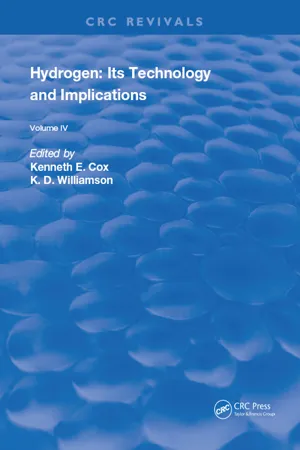![]()
Chapter 1
Hydrogen-fueled Surface Transportation
Chapter 1
HYDROGEN — FUELED SURFACE TRANSPORTATION
W. D. Van Vorst and R. L. Woolley
TABLE OF CONTENTS
1.1. Introduction
1.2. History of the Hydrogen Engine
1.3. Engine Cycles
1.3.1. The Air Standard Otto Cycle
1.3.2. Comparison of Fuel Properties
1.3.3. The Air Standard Diesel Cycle
1.3.4. Other Engine Cycles
1.4. Special Considerations for the Hydrogen Engine
1.4.1. Preignition and Flashback
1.4.2. Power and Efficiency
1.4.3. Emission of NOx
1.5. Special Considerations for a Hydrogen Vehicle
1.5.1. Hydrogen Storage
1.5.2. Range
1.5.3. Heat Exchange with Hydride
1.5.4. Refueling a Hydrogen Vehicle
1.5.4.1. Hot/Cold-Water Reservoirs
1.5.4.2. Collecting Low-Temperature Heat
1.5.4.3. Increased Thermal Capacity
1.6. Prototype Hydrogen Vehicles
1.6.1. Prototypes Using Liquid Hydrogen
1.6.2. Prototypes Using Fuel Cells
1.6.3. Prototypes Using Metal Hydrides
1.7. Vehicle Safety
1.8. Railroads
1.9. Comparison with Electric Battery Vehicles
Nomenclature
References
1.1. INTRODUCTION
Several factors justify the current interest in hydrogen-fueled surface transportation. When combusted with air, hydrogen offers emissions free of the major contributors to atmospheric pollution: unburned hydrocarbons, carbon monoxide, carbon dioxide, oxides of sulfur, and greatly reduced amounts of oxides of nitrogen under normal operating conditions. In the “ultimate” system of combustion with pure oxygen, emissions would be truly pollution free. The use of hydrogen also promises reduced dependency on imported energy, as indigenous sources of energy would be used to generate hydrogen as an energy carrier and storage medium. All energy resources are potential feedstocks for hydrogen production. This includes renewable resources (solar, wind, falling water, tidal, ocean, thermal, biomass, etc.) and noncarbon-containing reserves (uranium, tritium, deuterium, and geothermal) as well as fossil reserves, most notably coal and oil shale. The magnitude of the problems of production and distribution of hydrogen must not be dismissed lightly and is dealt with in Volumes I and II of this series. Finally, experience with hydrogen-fueled engines to date indicates that conventional engines may be converted to hydrogen service without expensive retooling. Major problems with the use of hydrogen are those of preignition and flashback and suitable storage on board the vehicle.
1.2. HISTORY OF THE HYDROGEN ENGINE
The use of hydrogen as an engine fuel is not new, and, indeed, it fueled what may have been the first internal combustion engine. This was the engine developed in 1820 by the Reverend W. Cecil on the vacuum principle.1 Hydrogen, burning with air, furnished a hot gaseous mixture which was expanded to atmospheric pressure and then cooled, resulting in a partial vacuum. The actual work was produced by the atmosphere forcing the piston back against the vacuum. The engine was said to have run satisfactorily, but vacuum engines in general never became practical and were supplanted by those in which power production was accomplished directly on the expansion stroke resulting from the increase in pressure due to combustion. As Cecil noted, however, “The engine, in which hydrogen gas is employed to produce moving force … may be inferior, in some respects, to many engines at present employed; yet, it will not be wholly useless, if, together with its own defects, it should be found to possess advantages also peculiar to itself.”
It was a stationary engine, of course, and its “peculiar advantages”, as claimed by Cecil, were that it could be located anywhere (in contrast to a waterwheel) and that it could be brought to full power very quickly (in contrast to the extensive warm-up period required for the steam engines of the day). More than 100 years later (1933), Erren and Hastings-Campbell2 were to write in much the same vein, with the advantages claimed to be those of reducing atmospheric pollution and aleviating the dependence of England on petroleum imports. Now in the 1970s, we read essentially the same sentiment with the added advantage of increased thermal efficiency.
The literature also reveals an English patent application by Bursanti and Matteucci in 1854 for a free-piston type engine which would burn hydrogen. Lichty notes that a prototype was constructed by Benini in 1856.3 Otto’s engines of the 1860s and 1870s used substantial proportions of hydrogen in the gaseous fuels employed before the advent of gasoline. Interestingly enough (since safety is a natural concern in considering hydrogen as a fuel), Otto’s first experiments with gasoline were so disastrous that he considered it much too unsafe and returned to the use of gaseous fuels.4 Development of the carburetor permitted safe and practical usage of gasoline and, indeed, had the effect of almost terminating interest in any other fuel.
Interest was revived during World War I. Stimulating factors were threatened shortages of gasoline and potential military uses of hydrogen. These military uses included a hydrogen-oxygen system for submarines and use of hydrogen engines to propel airships. Much of this work was done in Germany by Erren whose notes and records were lost in the bombings of World War II. The work is not well documented, although it is alluded to by others, particularly Erren and Hastings-Campbell2 and Weil.5 Apparently, Erren converted a wide variety of engines to run on hydrogen and suggested direct injection as a solution to the preignition and flashback problems (to be discussed later). The submarine research was motivated by the possibility of a completely condensible exhaust from a hydrogen-oxygen engine. Weil also notes the interest during the 1920s of the possible use of hydrogen either as the primary fuel or as a “fuel-extender” for the airships then under construction in England and Germany for long distance transportation of passengers and...
